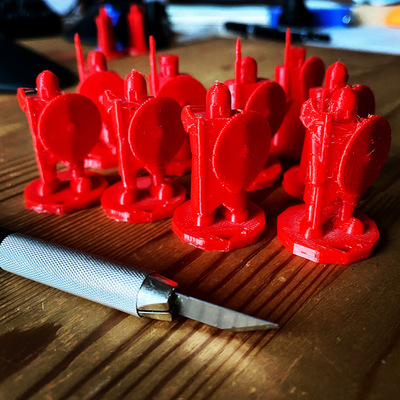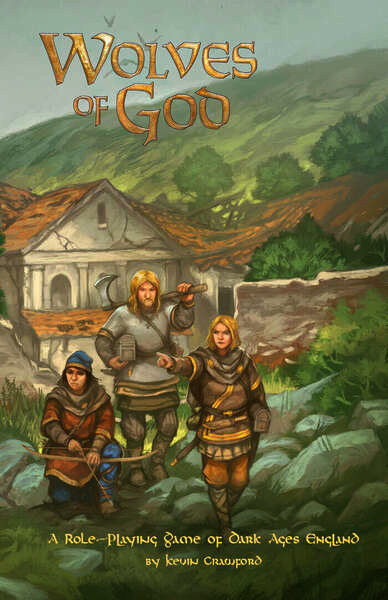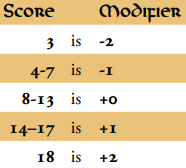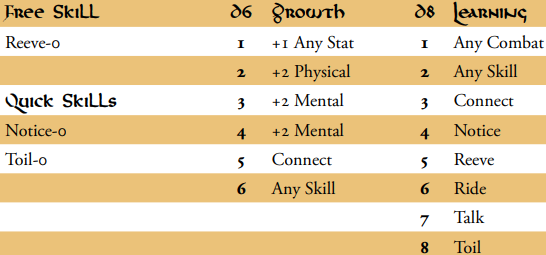
|
Damascene Wolves |
| 2021-01-11 |
Damascene Wolves

"You should use Wolves of God"... you know you don't want to use it, but at least, with the age, you know that, at least knowing why someone gives you a piece of advice does yield useful information.
The PDF on my iPad, I am introduced to the Rathmore Codex written in 710, it explains the rules for a role-playing game. The manuscript is said to be composed "in reaction to a significantly older tradition". The introduction doesn't say if the codex was written in Latin or in Old English, but the text by Kevin Crawford certainly is laid in beautiful english prose.
You know how PDFs go, no sense of depth, no pages privileged for opening by the binding, that sense of reading a specification. I tried to skip as much as possible the base rules to go for the "setting rules" and get taught about Dark Ages England.
I set a few mental bookmarks and told myself, OK that needs a second, serious, read. After a few weeks, the second read wasn't coming, but mentions of Kevin Crawford's work kept coming. I ordered the physical copy of the book.
I was expecting an A4 book and received an A5 one. That was a pleasant surprise, it's a beautiful object, but it springs to the closed state as soon as it can. Well, I can print reference parts from the PDF.
The layout of the document is single column, there aren't many tables and graphs and the it's full on prose, not game spec language. But it has marginalia, much like Halberds and Helmets does, and that helps a lot. Also, you can add your own marginalia weaving in the book your own epiphanies and clarifications.
Physical book, check. Let's ride in.
What made me fall from my horse? The skills and their checks.
You roll 2d6 (hoping your card count is less than 8 in case of a 7 roll, wait, that's for Catan...) and add the most relevant skill level and attribute modifier. If the result is higher than a given Difficulty Class (6 to more than 14), the check is a success.

There are 20 skills and 6 attributes (the usual 3d6 STR, DEX, CON, INT, WIS, and CHA), so that makes 120 possible skill checks.
For instance, if a character tries to help a fallen comrade, the gamemaster might decide for a INT/Heal check or a DEX/Heal check. If I am the fallen one, I hope the gamemaster will call for a DEX/Heal check (a broken arm, no complications please!).
A skill has 1 and four possible levels. The default level is -1, no proficiency, then it goes from 0 to 4. Level 0, ordinary proficiency, no exceptional skill. Level 1, for the veteran of the skill. Level 2, best skilled in the region. Level 3, best skilled in the kingdom, and Level 4, one of the living masters. The skill modifier thus goes from -1 to +4.
The skills are Connect, Craft, Exert, Gift, Heal, Hunt, Ken, Lead, Magic, Notice, Perform, Pray, Reeve, Ride, Shoot, Smite, Sneak, Spear, Talk, and Toil. It seems easy to add one or two more if needed, without breaking things.
From what I understood from an interview of Kevin Crawford, the skill system is inspired from Traveller. It blends nicely with the six attributes from Dungeons and Dragons.
Speaking of the elder, Wolves of God has saving throws as well.
The physical saving throw is a d20 roll roll against a Difficulty Class of 16 minus Character Level minus the best modifier (STR or CON). It's for saving against poison, disease, or exhaustion.
The evasion saving throw is a d20 roll against a DC of 16 minus the Character Level minus the best modifier (INT or DEX). It's used to dodge sudden perils.
The mental saving throw is a d20 rll against a DC of 16 minus the Character Level minus the best modifier (WIS or CHA). Saves from spells and woes that test the willpower and spirit.
(Note the Character Level computed in, the parent game, Stars Without Number goes with 15 minus the best modifier, the character level is not involved)
(Also note the absence of luck save, it was present in the first edition of Stars Without Number and is present in the upcoming Worlds Without Number)
Back to the skills, how does a character acquire them?
The character creation starts with rolling the six attributes, 6 times 3d6 attribute at will. If all the scores fall under 14, you're allowed to drop one of them and replace it with a 14. If you don't feel like rolling, assign 14, 13, 12, 10, 8, and 7.

You're then to choose (or roll for) a background. There are 10 of them: Ceorl, Crafter, Eorlishkind, Herdsman, Hunter, Minsterkind, Reeve, Scop, Thrall, and Wanderer.
Each of those backgrounds comes with a table like the one on the right.
A character from a Reeve background gets the Reeve (administer) skill (level 0) for free. If one is lazy he can pick the Notice and the Toil skills (level 0) and go on with character creation.
If you trust the dice, you can roll three times on eather the Growth or the Learning table. The pluses allow to increase an attribute (max 18). The rest are skills (Any skill for choose any skill, Any combat for choose any combat skill).
If no background suits you, the gamemaster may allow you to come up with a background and pick three skills.
The next step is choosing a class. The classes are Galdorman, a kind of sorcer, the Saint, the Warrior, and the Adventurer who has to choose two halves between half-saint, half-galdorman, and half-warrior.
The Galdorman gains the Magic skill at level 0. His sorcery points are 1 plus Magic skill plus the highest of his INT or CHA modifier.
The Saint gains the Pray skill at level 0. His holiness points are 1 plus the Pray skill plus the highest of his WIS or CHA modifier.
The Warrior has a bonus on his attacks (that increases as he increases in level), an ability to reroll once per fight to turn a miss into a hit, or a foe hit into a miss, a kind of warrior luck. The may pick an extra focus.
I love the reduced set of classes.
All the characters have 1d6 hit points per level, plus their CON modifier. 1 minimum hit point. The warrior has a +2, so 1d6 + 2 + CON modifier per level.
The hit points are rolled at each new level. If the sum is inferior to the previous max hit points, it becomes just the previous max + 1.
The maximum level is 10. I like that as well.
Then come focuses, special gifts, similar to 5th edition Feats. Each character has to pick one, Warriors get to pick two.
Each focus has two levels. You pick it, you have it at level one, you pick it a second time, you have it at level two.
Here are three examples:
Bringer of Endings: Your spear sparks red with the sunsets of men. Your terrible war-tree is a hard thing to flee. Level 1: Gain Spear as a bonus skill. If your weapon has a Shock value, increase it by one plus one third of your character level, rounded up. Level 2: If your weapon has a Shock value, it applies to any Armor Class equal to or lower than 20, unless it already affects a higher Armor Class than that
Healer’s Hand: You are a leech of skill and cunning, wise in ways to snatch the lives of men from the grave-grasp. Level 1: Gain Heal as a bonus skill. Roll 3d6 for all Heal skill checks, dropping the lowest die. Once per day per target, tend a person’s wounds for five minutes, restoring 1d6 hit points for every two character levels you possess, rounded up. Level 2: You can raise a man up from the brink of death without lasting ruin, and your prior healing ability is improved. When you tend a gravely wounded companion, any Scar rolls they make may be made twice, and the preferable one chosen. Your healing ability now cures 1d6+2 hit points per two character levels, rounded up.
Mighty Art: You wax great in a given art, either by nature or by nameless grace. Pick one skill that isn’t Pray or Magic. Gain it as a bonus skill. Level 1: Roll 3d6 on skill checks for that skill, dropping the low die. Level 2: Once per scene, reroll a failed skill check for that skill as an Instant action.
(I want healer hand in my party, hit points are scarce here, we need that guy and his gift)
The Mighty Art focus shows how a mechanism reminiscent of the 5th edition Advantage can be had in this system: roll 3d6 and choose the two highest dice.
If a focus grants as a bonus a skill you already have, that skill becomes level 1. If you already have level 1 for the skill you may pick another skill (save for Magic). A first level character may not start with level 2 or more in a skill.
Pick a name, list relations to other characters in the party, and choose a starting equipment package and you are good to go.
The character creation spans the pages 8 to 40 of the rulebook, better to print those pages else the players will ruin the book roaming from one focus description to the next.
The flexibility of the skill system made me brush the character creation with broad strokes. I didn't write anything about combat.
Combat begins with initiative, each side rolls 1d8 plus its best DEX modifier.
To hit, one has to roll a d20 and reach the target's Armour Class. The skill level (Smite, Spear, or Shoot, depending on the weapon or a potential focus involved), an attribute modifier, and a Warrior attack bonus are added as well.
A one is a always a failure, a twenty is always a success.
Some weapon may inflict "shock damage" on a miss. For example, a spear has 2 points of shock against an AC of 13. A missed spear strike inflicts 2 points of damage anyway if the target's AC is less or equal to 13.
Going to 0 hit points means death or a scar. The scar table is properly scary.
The round clocks at 6 seconds, with a movement of 30 feet. Actions are main actions, move actions, on turn actions, and instant actions. All in all it feels close to 5th edition.
The game has reaction and morale rules similar to what B/X games have.
I like Wolves of God, I like the Stars Without Number family basic system. It's an elegant pattern of a system. At the heart, Attributes + Skills, The background system layers on top of it. Then the classes and their subsystems come on top (I haven't written anything about spells and miracles but you can guess where they fit). The focuses add more fireworks.
Attributes, Skills, Backgrounds, Classes, Focuses.
It feels right.
